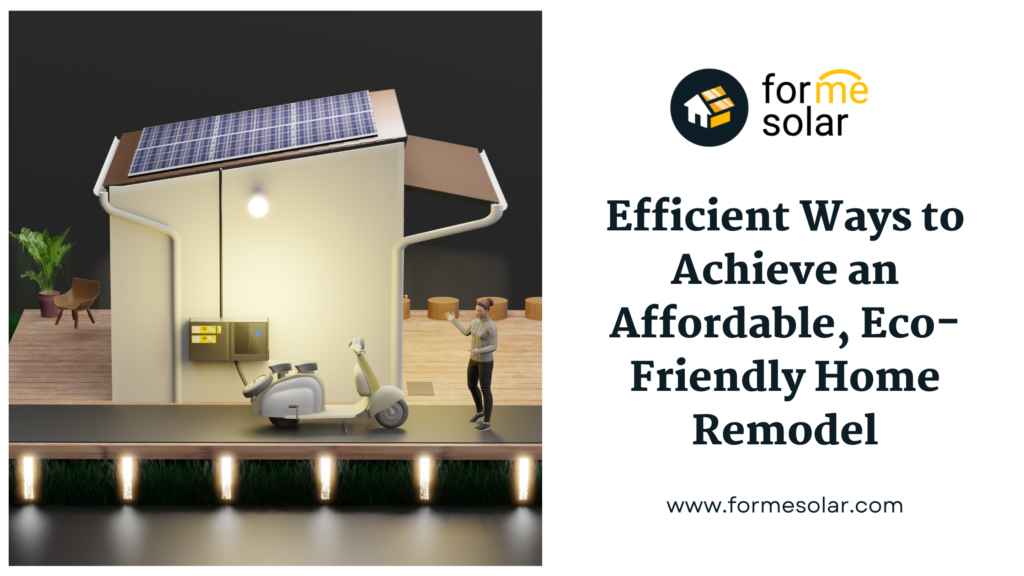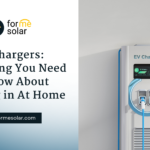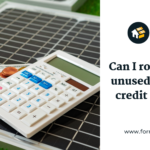
Table of Contents
Efficient Ways to Achieve an Affordable, Eco-Friendly Home Remodel
In an era where environmental consciousness is on the rise and energy costs are a growing concern, more homeowners are turning to eco-friendly solutions like solar panels and solar batteries to transform their homes into sustainable, green havens. Not only do these upgrades reduce your carbon footprint, but they can also save you money in the long run. This article will provide you with a comprehensive guide on efficient ways to achieve an affordable, eco-friendly home remodel using solar panels and solar batteries. We'll walk you through the benefits, installation process, and maintenance, making the transition to a greener home simpler than ever.
Understanding the Basics
Before we jump into the nitty-gritty of adding solar panels and batteries to your home renovation, let's pause for a moment to grasp the basics.
Solar Panels: Solar panels, also known as photovoltaic panels, are devices that convert sunlight into electricity. They consist of numerous solar cells made from semiconductor materials like silicon. When exposed to sunlight, these cells generate direct current (DC) electricity, which can be converted into alternating current (AC) using an inverter. Here are some key benefits of incorporating solar panels into your home:
- Reduced Energy Bills: Solar panels can significantly reduce or even eliminate your electricity bills, depending on your location and system size.
- Environmental Impact: Solar power is clean and renewable, reducing your carbon footprint and helping combat climate change.
- Energy Independence: Generate your electricity, reducing reliance on the grid and potential power outages.
- Government Incentives: Many governments offer tax incentives and rebates for installing solar panels.
Solar Batteries: Solar batteries, often referred to as energy storage systems, store excess electricity generated by your solar panels for use during cloudy days or at night. They ensure a continuous power supply and maximize your energy savings. Here are some advantages of adding solar batteries to your system:
- Energy Backup: Store surplus energy for use when the sun isn't shining.
- Energy Efficiency: Minimize energy waste and optimize your solar panel system's performance.
- Grid Independence: Decrease your reliance on the grid and reduce your vulnerability to power outages.
- Cost Savings: Reduce peak-hour electricity costs and potentially qualify for additional incentives.
Now that we've covered the basics, let's explore the steps to achieve an affordable, eco-friendly home remodel using solar panels and batteries.
Step 1: Assess Your Energy Needs
Before diving into a solar panel installation, it's crucial to determine your energy consumption and needs. This step will help you determine the size of the solar panel system and battery storage capacity required for your home. Here's what you need to do:
- Gather Your Energy Bills: Collect your electricity bills from the past year to understand your monthly and annual consumption.
- Evaluate Your Goals: Define your objectives, whether it's to reduce your electricity bills, achieve energy independence, or lower your carbon footprint.
- Consult a Solar Expert: Reach out to a qualified solar installer or energy consultant to assess your home's solar potential. They can help you calculate the ideal system size and battery capacity based on your goals and location.
Step 2: Choose the Right Solar Panels
Selecting the right solar panels is crucial for the success of your home remodel. Consider these factors when making your choice:
- Efficiency: Higher efficiency panels generate more electricity per square foot, making them ideal for homes with limited roof space.
- Durability: Opt for panels with a solid warranty and a proven track record to ensure they withstand harsh weather conditions.
- Aesthetics: If aesthetics are important to you, look for sleek, black panels that blend seamlessly with your roof.
- Cost: Balance the upfront cost of panels with their long-term efficiency and durability to make the best financial decision.
Step 3: Determine the Optimal Panel Placement
The orientation and tilt of your solar panels significantly impact their energy production. Here's how to ensure optimal panel placement:
- Roof Orientation: Solar panels generally perform best when facing south in the northern hemisphere and north in the southern hemisphere. East and west orientations can also work, but they may produce slightly less energy.
- Tilt Angle: The ideal tilt angle for solar panels is approximately equal to your latitude. However, the optimal angle may vary depending on your location and specific circumstances.
Step 4: Installation and Permitting
Once you've chosen your solar panels and determined their placement, it's time to install them. This step involves several important tasks:
- Find a Reliable Installer: Select a reputable solar panel installation company with experience in your area.
- Obtain Necessary Permits: Ensure you have all the required permits and approvals from your local authorities.
- Install Inverter and Battery: If you're incorporating a solar battery, have it installed along with the inverter to convert DC electricity to AC.
- Connect to the Grid: Your solar panel system may be connected to the grid to sell excess electricity back to your utility company. Ensure the proper interconnection is in place.
Step 5: Monitor and Maintain Your System
Once your solar panel system and battery are up and running, it's important to monitor and maintain them for optimal performance:
- Regular Cleaning: Keep your solar panels clean to maximize their efficiency. Remove dust, debris, and bird droppings that can obstruct sunlight.
- Inverter and Battery Maintenance: Schedule periodic inspections and maintenance for your inverter and battery to ensure they function correctly.
- Monitor Energy Production: Use monitoring software or apps to track your system's energy production and detect any issues promptly.
Step 6: Enjoy the Benefits
With your solar panel system and battery in place, you can now start reaping the rewards:
- Lower Energy Bills: Watch your electricity bills decrease as you generate your power.
- Energy Independence: Enjoy uninterrupted power during outages and reduce your reliance on the grid.
- Environmental Impact: Reduce your carbon footprint and contribute to a greener, more sustainable future.
Incorporating Sustainability into Your Plans
When you set out on a home remodeling journey, especially when contractors are involved, it's a smart move to collaborate with a certified professional experienced in sustainable remodeling. These specialists bring a wealth of knowledge to the table, enabling them to assist you in various critical aspects of your project.
One of the most significant advantages of working with these experts is their ability to provide accurate estimates of project costs. They can help you develop a clear budget that aligns with your goals and financial resources, ensuring that you're not met with any unexpected financial surprises along the way.
Moreover, certified sustainable remodeling professionals can guide your spending choices. They know which plans and materials make the most significant impact on your home's eco-friendliness. By leveraging their expertise, you can make informed decisions that prioritize sustainability without compromising on the functionality and aesthetics of your remodel.
In essence, these professionals act as your partners in creating a home that not only meets your desires but also contributes positively to the environment. Their insights and recommendations can be invaluable in achieving a successful, sustainable home remodel.
Financing Your Remodel
Home renovations, even with potential government incentives and support from utility companies, can strain your finances. Here are some financing options to consider:
1. Use Savings
Paying for your remodel with your savings is the most cost-effective approach. However, if your project expenses exceed your available funds, other options exist.
2. Home Equity Loans or Lines of Credit
For homeowners with sufficient equity in their homes, home equity loans or lines of credit typically offer lower interest rates and extended repayment terms.
3. Personal Loans
Personal loans are an option for those who prefer not to use their homes as collateral for the project. Borrowers with good credit can often secure personal loans with low interest rates, and these loans are typically funded quickly, often within a week.
When considering financing options, it's essential to compare the terms and features of each lender to find the most favorable rates and terms for your specific needs.
4. Energy-Efficiency Rebates and Incentives
Explore available rebates and incentives offered by local and state governments, as well as utility companies. These can significantly reduce the upfront costs of energy-efficient and solar technologies. Tax credits and incentives may be available for solar panel installations, smart home systems, and energy-efficient appliances.
5. PACE Financing for Solar
PACE financing isn't limited to energy efficiency alone; it can also be used for solar panel installations. PACE programs can be a practical way to finance your solar project while spreading the payments over an extended period.
6. Energy-Efficiency Mortgages (EEMs)
If you're considering a substantial remodel that includes energy-efficient upgrades, you might explore Energy-Efficiency Mortgages. These mortgages allow you to include the cost of energy-efficient improvements in your home loan. While this option might extend the term of your mortgage, it can help you finance green and smart upgrades more affordably.
7. Combining Financing Options
In some cases, combining financing options can be a practical strategy. For instance, you might use your savings for a portion of the project, secure a home equity loan for solar panel installation, and explore rebates and incentives to offset costs further.
In conclusion, embarking on an eco-friendly home remodel doesn't have to be a financial burden. With careful planning and smart financing options, you can transform your living space into a more environmentally friendly and enjoyable haven without draining your wallet. By making conscious decisions during your remodel, you can achieve a greener, more sustainable home while staying within your budget.
Ready to make the switch to solar? Take it a step further by considering solar panels for your home. Solar energy not only reduces your carbon footprint but also offers long-term savings on energy bills. It's a powerful way to make your home more sustainable and energy-efficient. So, if you're ready to embrace the future of eco-friendly living, explore the possibilities of a solar-powered home today! Contact us to get started on your solar home journey!













